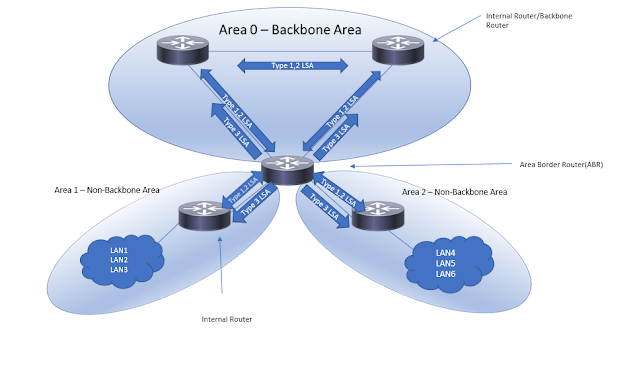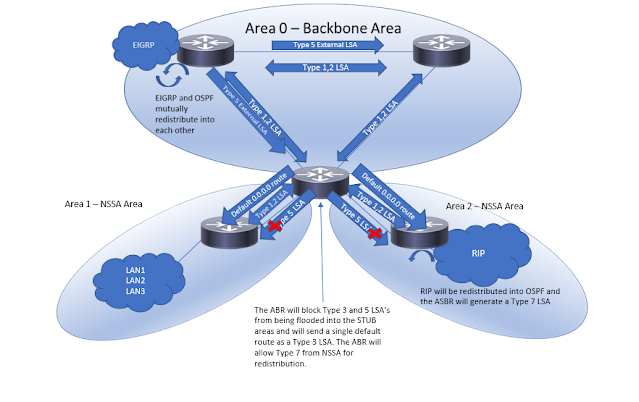OSPF Areas and Router Types
Re-call that OSPF maintains an identical copy of the link state database on every router within an area by flooding LSA's. The maintenance of this database and flooding can sometimes overburden the CPU resources on routers, particularly when there are many routers in the OSPF area. To overcome this issue OSPF has the concept of areas. An OSPF area is just a logical grouping of OSPF routers, breaking one domain into smaller sub-domains, to reduce the flooding domain. Breaking up the single domain into smaller ones accomplishes a couple of things:
- Hides topology information for routers outside of the domain
- Reduces the impact on the routers memory as adding areas reduces the size of the database
- A smaller link state database also reduces the load on the CPU
Areas are identified with a 32-bit ID called the Area ID. The area can be expressed as either dotted decimal or a decimal number. Since there can be multiple areas, what do we call the routes from each area?
- Intra-Area Routes: These are routes that are shared between routers in the SAME area
- Inter-Area Routes: These are routes that are shared between routers in DIFFERENT areas
- External Routes: These are routes that are injected or imported INTO OSPF and shared between routers within the OSPF domain.
Area 0(or 0.0.0.0) is the Area ID is usually reserved for the backbone. The Backbone Area is used to summarize the topologies of non-backbone areas to other non-backbone areas. All areas SHOULD attach to the backbone as that is how non-backbone areas exchange routes. There are five other area types besides the backbone.
Three through six would be considered non-backbone areas also but these are different than standard areas. Standard non-backbone areas don't have restrictions on LSA's like the other area types.
Non-Backbone Areas are standard areas other than area 0. In our example below, both Area 1 and Area 2 are non-backbone areas. These areas aren't special and will allow Type 3, 4, and 5 LSA's through.
Here is an example of what a multi-area topology might look like.
Before we go any further on areas let's talk about router types. There are four router types within OSPF. Note that a router CAN be classified by more than one type depending on the topology.
- Internal Router: Internal routers are routers with all interfaces residing in the same area and have, as a result, a single link state database
- Area Border Router (ABR): ABR's are routers that 'border' two areas. They connect one or more areas to the backbone. These routers have separate link state databases for each area. The purpose of the ABR is to summarize the topology information of its areas into the backbone.
- Backbone Router: A backbone router is just a router with at-least one interface in area 0, the backbone.
- Autonomous System Boundary Routers (ASBRs): An ASBR is a router that injects routes that were learned from outside of the OSPF domain. These routes could be from another IGP, EGP, or static, then redistributed into OSPF. The image below displays an ASBR router that is learning routes from EIGRP and then redistributing them into OSPF and vice versa








Comments
Post a Comment